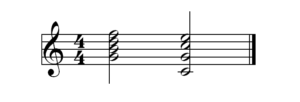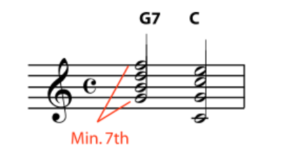Previous Page | Next Page | Table of Contents | Diagram Center Home
Source: Catherine Schmidt-Jones. “Consonance and Dissonance.” Understanding Basic Music Theory. Boundless, 30 Oct. 2014. Retrieved 04 Mar. 2015 from https://www.boundless.com/users/232513/textbooks/understanding-basic-music-theory/harmony-and-form-5/consonance-and-dissonance-33/consonance-and-dissonance-133-13607/
This is a page from a high school and college general education textbook. It includes music notation with additional annotated diagrams.
Making This Image Accessible
This image can be made accessible using image descriptions, or by creating additional supporting files in a variety of formats such as MusicXML, MIDI, or standard audio files (MP3, WAV or AIFF files). The choice of modality varies depending on the information to be conveyed, grade level, student knowledge and experience, and the image itself.
How an image description is displayed depends on the reading tool being used. In most mainstream reading tools, the description will not be displayed at all, but in tools designed for accessibility (or mainstream tools with accessible features enabled), the description could be displayed below the image, voiced as part of the content, or both.
MusicXML
As an XML file format, MusicXML shows promise for digital publishing and can be accessed with supported assistive technology. However, MusicXML is not currently supported in the DAISY or EPUB specification, so it cannot be embedded in page content. MusicXML files can, however, be served separately for use with braille translation software or music-aware braille display and speech-access systems. MusicXML is also widely supported by music notation software that can create enlarged notation to be viewed on the screen or printed. This allows further manipulation of the music notation, audible playback in real time using synthetic music, or export to standard audio formats.
For example, the code used to create this notation:
Click or select image to zoom
looks like:<?xml version="1.0" encoding="UTF-8" standalone="no"?>
<!DOCTYPE score-partwise PUBLIC "-//Recordare//DTD MusicXML 2.0 Partwise//EN" "http://www.musicxml.org/dtds/partwise.dtd">
<score-partwise version="2.0">
<work>
<work-title>GseventhC</work-title>
</work>
<part-list>
<score-part id="P1">
<part-name></part-name>
<score-instrument id="P1-I1">
<instrument-name>Piano 1[Ch1]</instrument-name>
</score-instrument>
<midi-instrument id="P1-I1">
<midi-channel>0</midi-channel>
<midi-bank>1</midi-bank>
<midi-program>1</midi-program>
<volume>100</volume>
<pan>-1</pan>
</midi-instrument>
</score-part>
</part-list>
<part id="P1">
<measure number="1" width="695">
<attributes>
<divisions>6720</divisions>
<key>
<cancel>-7</cancel>
<fifths>0</fifths>
<mode>major</mode>
</key>
<time>
<beats>4</beats>
<beat-type>4</beat-type>
</time>
<clef number="1">
<sign>G</sign>
<line>2</line>
</clef>
<staff-details number="1" print-object="yes">
<staff-lines>5</staff-lines>
<staff-size>69.17</staff-size>
</staff-details>
</attributes>
<note>
<pitch>
<step>F</step>
<octave>5</octave>
</pitch>
<duration>13440</duration>
<voice>1</voice>
<type>half</type>
<stem default-y="-35.00">down</stem>
</note>
<note>
<chord/>
<pitch>
<step>D</step>
<octave>5</octave>
</pitch>
<duration>13440</duration>
<voice>1</voice>
<type>half</type>
<stem default-y="-45.00">down</stem>
</note>
<note>
<chord/>
<pitch>
<step>B</step>
<octave>4</octave>
</pitch>
<duration>13440</duration>
<voice>1</voice>
<type>half</type>
<stem default-y="-55.00">down</stem>
</note>
<note>
<chord/>
<pitch>
<step>G</step>
<octave>4</octave>
</pitch>
<duration>13440</duration>
<voice>1</voice>
<type>half</type>
<stem default-y="-65.00">down</stem>
</note>
<note>
<pitch>
<step>E</step>
<octave>5</octave>
</pitch>
<duration>13440</duration>
<voice>1</voice>
<type>half</type>
<stem default-y="30.00">up</stem>
</note>
<note>
<chord/>
<pitch>
<step>C</step>
<octave>5</octave>
</pitch>
<duration>13440</duration>
<voice>1</voice>
<type>half</type>
<stem default-y="20.00">up</stem>
</note>
<note>
<chord/>
<pitch>
<step>G</step>
<octave>4</octave>
</pitch>
<duration>13440</duration>
<voice>1</voice>
<type>half</type>
<stem default-y="5.00">up</stem>
</note>
<note>
<chord/>
<pitch>
<step>C</step>
<octave>4</octave>
</pitch>
<duration>13440</duration>
<voice>1</voice>
<type>half</type>
<stem default-y="-15.00">up</stem>
</note>
<barline location="right">
<bar-style>light-heavy</bar-style>
</barline>
</measure>
</part>
</score-partwise>MIDI
The Musical Instrument Digital Interface (MIDI) specification was originally devised to support interoperability and data sharing for music synthesizers and electronic instruments. The Standard MIDI File format (*.SMF or *.MID) provides a standardized way for musical information to be saved, transported, and opened in other systems. It can also include note values, timing and track names, and the integration of lyrics and other information as metadata. Though not as versatile as MusicXML, MIDI files are still attractive for general accessibility purposes in that they can be opened in music notation editors, used with music-aware braille display and speech access systems, or simply played as audio with many commonly used digital audio players. The MIDI file linked below was created from the previously discussed MusicXML code.
EPUB does not natively support the MIDI format. Please see the source files for an alternative means of downloading this file.Recorded Audio
Music notation can be simply converted to a synthetic recorded audio format such as an MP3 file. Most common music notation editors will provide export both to the Standard MIDI File format or a wide variety of recorded audio formats, such as WAV, AIFF, or MP3 files, as well as importing from and exporting to MusicXML. Even lyrics can be “sung” synthetically in supported notation editors; however, from an accessibility perspective, it is preferred to also provide any embedded lyrics in text format. While exporting to recorded audio does not retain any of the notation information (unlike conversions to the MIDI format), it nonetheless provides audio access using a file format that is almost universally supported with any digital device that can display the text (as long as it has audio output capabilities), and can be easily embedded in DAISY, EPUB, or standard HTML documents. The same music notation example is linked below, but this time exported to MP3 from a music notation editor.
Text or Audio Description
This textbook includes a number of images of music notation with additional annotated diagrams. These diagrams and embedded text have been overlaid on top of musical notation. They are not part of the notation and will have to be described using alternate text, regardless if the notation itself has been incorporated as MusicXML, rendered as MIDI, or a synthetically derived recorded audio format. Here is one of the annotated examples from this book. Two sample descriptions are provided.
Click or select image to zoom
An appropriate brief description for this diagram is:“A G seventh chord, showing the minor seventh between the root G and the F above, which is followed by a C major chord.”
A much longer description would be:
“A single measure of music in common time in the key of C. Two 4-note chords are shown on the treble clef. Both chords are half notes. The first is a G seventh chord consisting of the pitches G, B, D and F, where the G and F form a minor seventh. The second chord is C major consisting of the pitches C below the staff, G, C, and E.”
While the longer description reveals more details about the music, in the context of this text, much of it is unnecessary. The point of the inclusion of the graphic was to give an example of a dissonant cord resolving to a consonance. While in some contexts a longer description would be warranted, the brief description and audio recording would suffice in getting across the essential instructional intent. However, inclusion of the MusicXML or MIDI file would provide many more accessibility options for a blind student who wanted to explore the notation in more detail since the specifics of the music notation would be retained.
Previous Page | Next Page | Table of Contents | Diagram Center Home



